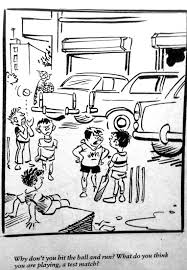
Transport 65 years ago .. Nanganallur – J.K.Sivan.
When I think of how the life pattern has now changed, it makes me wonder. I recall the days when i was an employee of Electricity Dept in 1956, in Mount Road, next to Arts College . Mount Road was later renamed is now Anna salai. Many of us , for many years walked from Vadapalani to Arts College Mount road. It took 60 t0 90 minutes.
Everyday, whether it was raining or not, by about 8.15 am or 8.30 am most of the office goers were ready with our tiffin boxes and bags waiting at Kodambakkam bus stand awaiting bus. The bus stand was at Choolaimedu Road-Arcot road junction. All eyes were looking towards west to sight the blue bus. The blue bus numbered 25 bound for Triplicane from Vadapalani would be almost crowded and yet we managed to get into it. Three used to sit on a two seater the third one half seated at the corner.Two and half annas were charged for travel up to Arts college stop in Mount Road, On many days there was delay in travelling because the bus would have to wait at the Kodambakkam Railway gate level crossing, for two or three trains to pass and the gates were opened only after bout 20 minutes to half an hour waiting. It depended on how many trains would cross. half of the seats in the bus was reserved for ladies and men normally would not occupy ladies’ seats but stand holding the road above head. At times some ladies would not object some old passenger seated by their side until some other lady passenger boarded the bus in between.
The route was Kodambakkam High road, turn at Nungambakkam new tank road and take the long road Nungambakkam High road to Gemini, turn left and proceed on Mount road and turn right after rounding about the statue in front of Hindu Office, and turned right opposite Elphinston theatre towards Wallajah road for reaching Triplicane High Road. Incidentally the Kodambakkam high road was not even and the bumpy travel shook the standees in the bus to toss left and right holding the rod above for safety. Some fellow passengers obliged the standees by accepting their bags or boxes so that they could hold the rod with both hands.
There were many cyclists on the roads in those days, who did not avail the bus service. We viewed the cyclists to be rich and affordable people. Any distance they would pedal and reach in time without the need for a bus to carry them.
Doubles were not permitted to trvel on a cycle in busy areas such as Mount Road, Triplicane High or Wallajah road, and the police whenever spotted a cyclist carrying a passenger in the back seat , he would stop the cycle, remove air from the tyre and make the cyclist suffer. There were not many cycle repair shops where cycle tyres were pumped with air. Many cyclists could not afford to carry a pump with the cycle. some times long walks pushing the cycle to the next nearest cycle shop was an ordeal, particularly when in a new area. That was the punishment. Some police men would take the cycle to nearby police station. There was for some time licence for cycle riding. I remember it was a small metal plate with a number and we have to show it whenever demanded. It was fixed below the seat on the frame of the cycle if I remember correct.
Travelling without lamp after 6 pm. Most of the cycles were fitted with oil lamp and it was stolen if not chained and locked and it was an offense to ride on a cycle without lamp. Whenever there was any police man spotted, the cyclist would get down and push the cycle physically and ride again after the police man disappeared. Battery lamps were a boon later after some years. Some costly cycles were fitted with dynamos for getting energy by the dynamo rotating if set to touch the running back wheel. The lamp was fixed to cycle in the middle of front hand bar. Miller lamps were quite popular and many stole the lamps if the cycles were parked in open areas even if they were chain locked.
There were not many one-way streets in those days. Later Police began catching the cyclists violating the rule and riding in one way streets. The oil lamp betrayed many times as the cyclist has to be always attentive to ensure the lamp is lighted and burns. It was not for any use in illuminating the path way but to satisfy the police man. He would stop the cyclist, touch the lamp. If it was hot, then he would allow the cyclist to proceed after again lighting the lamp. If it was not hot, it is a confirmation that the cyclist had not lighted the lamp for long and he would demand fine of Rs 1 or 2 some times. If the cyclist pedalled fast and disappeared then he is free from any punishment. The police man on foot would shout and scold him.
In many places cycle shops and repairers hired cycle for hour basis. if we gave the name of a person known to the cycle shop or repairer and paid advance hire he would not mind permitting us to use the hire cycle. The hired cycle would not provide any smooth ride. The seats were not covered and the metal injured the back. The breaks would not cooperate and yet it served the purpose of reaching the destination and return timely. There were not scooters or two wheeler as we see plenty of them today on the roads.So is the case with private cars. All roads were not served by buses and it was a time the horse carts were thriving and benefited passengers. To avail horse cart riding, one has to wait for maximum 4 persons to fill the horse driven cart. 8 Annas was the charge for longest distance. Hand rickshaws were luxury and the rickshaw puller obliged a comfortable ride and charged a fancy rate of 2 rupees to 3 rupees from Kodambakkam railway station to vadapalani.
L



